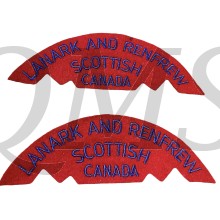Shoulder flashes Lanark and Renfrew Scottish Regiment of Canada , 4th Canadian Division
In 1938, the present commander, Col. Beatty, succeeded Col. Gardner. During this visit of the King and Queen in 1939, his regiment was given a prominent part in the ceremonies at Ottawa and Kingston.
At Ottawa the regiment was credited with preventing what might have developed into a serious situation on the evening Their Majesties attended a parliamentary dinner at the Chateau Laurier. Over 300 strong, the battalion’s duty was to line Mackenzie avenue and control the traffic and crowds. About eight o’clock, the crowd began to press forward and civilian “casualties” occurred right and left. The situation rapidly got out of hand. But the pipe band was brought forward and played in front of the Chateau. Soon the temper of the crowd changed and the situation was under control.
A personal bodyguard for the Queen was selected from the unit and stationed in the hall leading to the East Block of the Parliament Buildings. It was commanded by Capt. A. Wallace.
At the outbreak of the present war, guards were established for a time at each armory, and shortly afterward the regiment was required to detail a guard of two officers and 50 other ranks over the Magazine, Pump House, and Main Gate at Petawawa camp.
The regiment provided a guard over aliens interned at Centre Lake, in December, 1939. Within a short time, a complete company of 250 officers and men were supplied to the Governor General’s Footguards, under command of Major Harold Baker.
Appointments announced in 1943 were : D. E. Jamieson, Smiths Falls, and now of Pembroke, will shortly receive his commission and will be appointed adjutant. Lieut. W. R. Eliott, Renfrew, is training officer. The following N.C.O.’s will be appointed assistant instructors with the rank of warrant Officer H, Sgt. Major J. B. Rouselle, Headquarters Company, Renfrew ; C.Q.M.S.P.J. Rooney “B” Company, Almonte ; C.Q.M.S.C.A. Clarke, “C” Company, Smiths Falls, and Sgt. L. E. Fagan, “D” Company, Carleton Place.
The spring of 1946 marked a turning point in the history of this famous regiment as it came under the scrutiny of the Department of National Defense under new plans announced for the Canadian Army in the post-war period.



